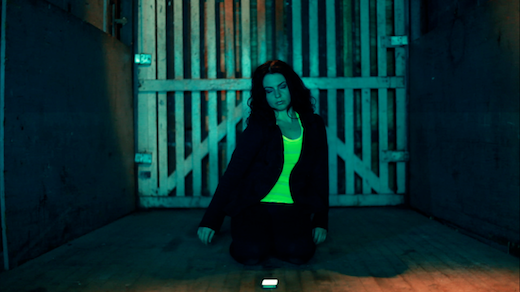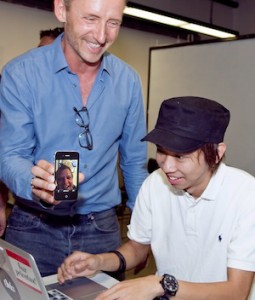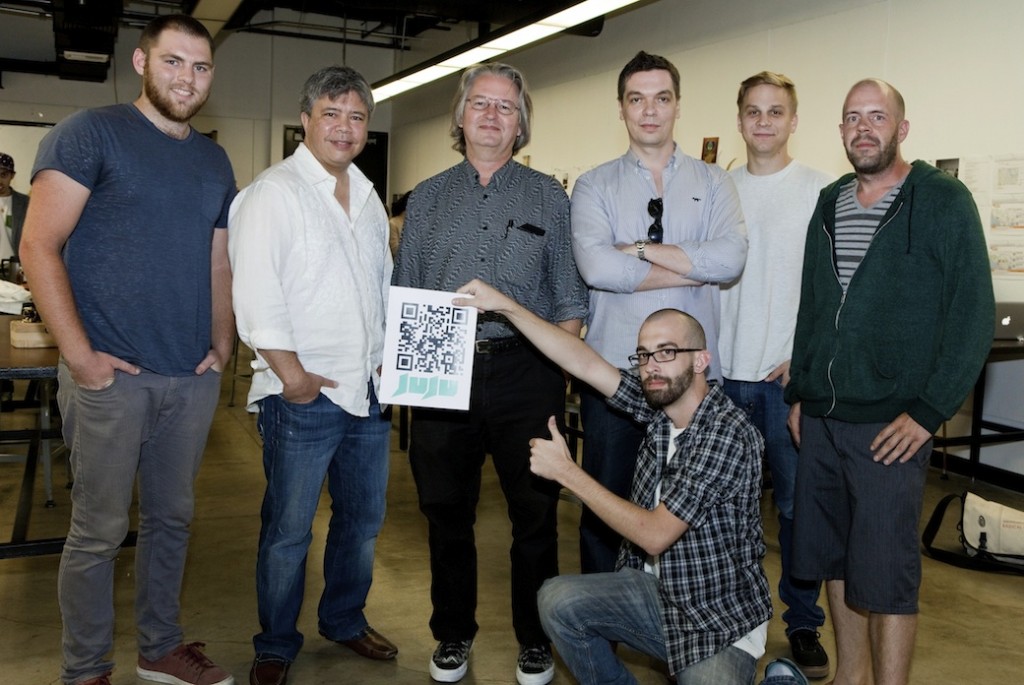
Still from the promotional video for Juju, a student-created augmented reality application.
This past summer term, Art Center welcomed back its first visionary-in-residence, science fiction author Bruce Sterling (Schismatrix, Islands in the Net, The Caryatids) to co-teach an augmented reality (AR) transdisciplinary design studio with Graphic Design instructor Guillaume Wolf called Augmenting Reality.
Not certain what AR is exactly? You’re not alone. For the studio, Sterling and Wolf defined AR as a software program that must: 1) mix the virtual with the real, 2) be interactive in real time and 3) register in three dimensions.
AR is an industry still on the cusp, and applications are only now starting to sneak out of the labs and into consumers’ hands. “It may even be a bit before the cusp,” Sterling says of the AR industry. “It’s an old technology, but it’s a baby industry.”
In the course—hosted by the College’s Graphic Design Department and sponsored by Amsterdam-based Layar, a company whose AR platform claims more than one million active users—teams of students designed both concepts and prototype AR apps that ranged from virtual pets to an augmented “spiritual reality” experience.

Layar's Maarten Lens-FitzGerald gets some FaceTime with Graphic Design student Shi Jie Lim and Graphic Design Department chair Nik Hafermaas. Photo: Alex Arestei, Layar.
“I was impressed by the student’s concepts, execution and their presentation,” says Maarten Lens-FitzGerald, general manager and co-founder of Layar, who watched the teams’ final presentations virtually (during the final he was “passed” around the classroom on an instructor’s smartphone). “Even with innovative media, it’s still important to be able to tell the story using mainstream media. Not all AR people know this; but the students did.”
Words, no doubt, that are music to instructor Wolf’s ears, who wanted to make sure the students were designing based on something people can actually connect with.
“Why are people interested in anything? It’s not just about design, it’s about the psychology behind it,” says Wolf of what he tries to impart to his students. “Why is a product sexy? Why do we want it? How does a designer create that desire?”
(Read more, and view videos of the work, after the jump.)
For example, take a look at this promotional video for Juju, a smartphone application—created by Graphic Design students Edward Schofield and Jesse Merrel and Photography and Imaging students James Goodnight and Drew Roberts—that allows users to peek inside Los Angeles nightclubs as they wait outside the venue.
Sexy? Check. Desire created? Check. But how exactly does it work? That was an important aspect of the course—designing an app that, with proper funding, could be further developed into an actual product.
Here’s how Juju would function:
And while Juju’s goal is to help users experience the trendiest nightspots, the team behind the program have even higher aspirations for their app. “This technology can be applied beyond the club environment,” said Schofield during the team’s final presentation, pointing out that Juju could be a hit in lecture halls, conferences, large-venue concerts and sporting events by allowing people sitting in the back rows to catch all the nuances in the performances of their favorite musicians or athletes.
The creative team behind the AR app Harvest—Graphic Design students Trevor Freel, Eugene Seo, Simon Tien and Daniel Young—decided to target a very different demographic: the millions of Americans with food allergies and other special dietary needs or restrictions.
“For our audience, their everyday shopping experience consists of sifting through label after label of technical information,” said Daniel Young before demonstrating Harvest to the class. “This experience deters them from trying new products, which is the opposite of what the supermarket wants.”
Featuring a comprehensive and easy-to-understand graphical language, Harvest allows grocery shoppers to: scan in real-time their local store’s aisles using tags like “gluten-free,” “dairy-free” and “fat-free;” determine whether an item fits their dietary restrictions by simply pointing their smartphone; and receive personalized recommendations, recipes and reviews from other users.
See the team’s concept video:
Harvest — Safe Food Discovery from Eugene Art Seo on Vimeo.
Sterling, who developed an AR application of his own during the studio, says delving into the AR industry has been satisfying for him for two reasons: science fiction writers have been talking about AR since the late 80s and now its becoming a reality; and AR is one of the few genuinely new platforms for development that have appeared during this decade.
“It’s not a computer game, it’s not Web 2.0 and it’s not social networking,” says Sterling of AR. “It has components of all those things, but its really another space in which to work. It really is a bare bones electronic frontier.”









